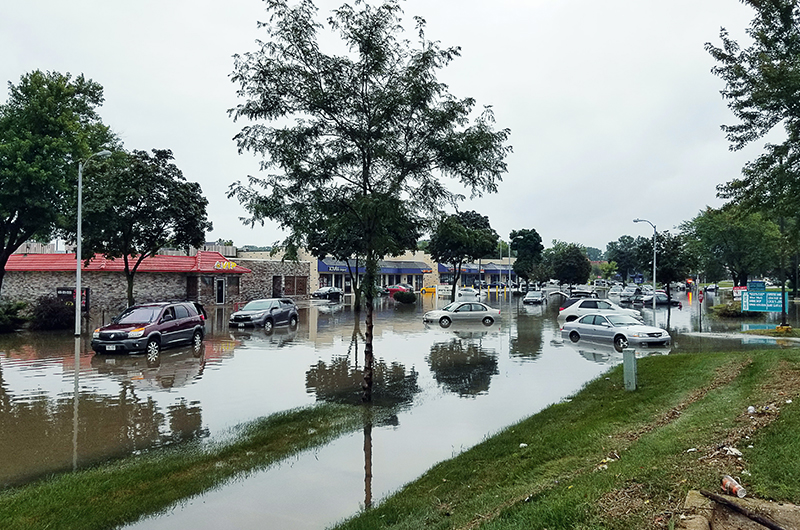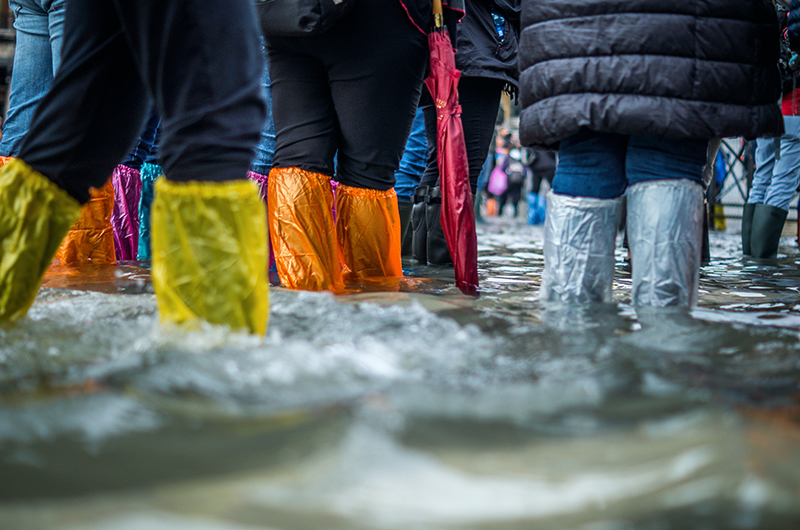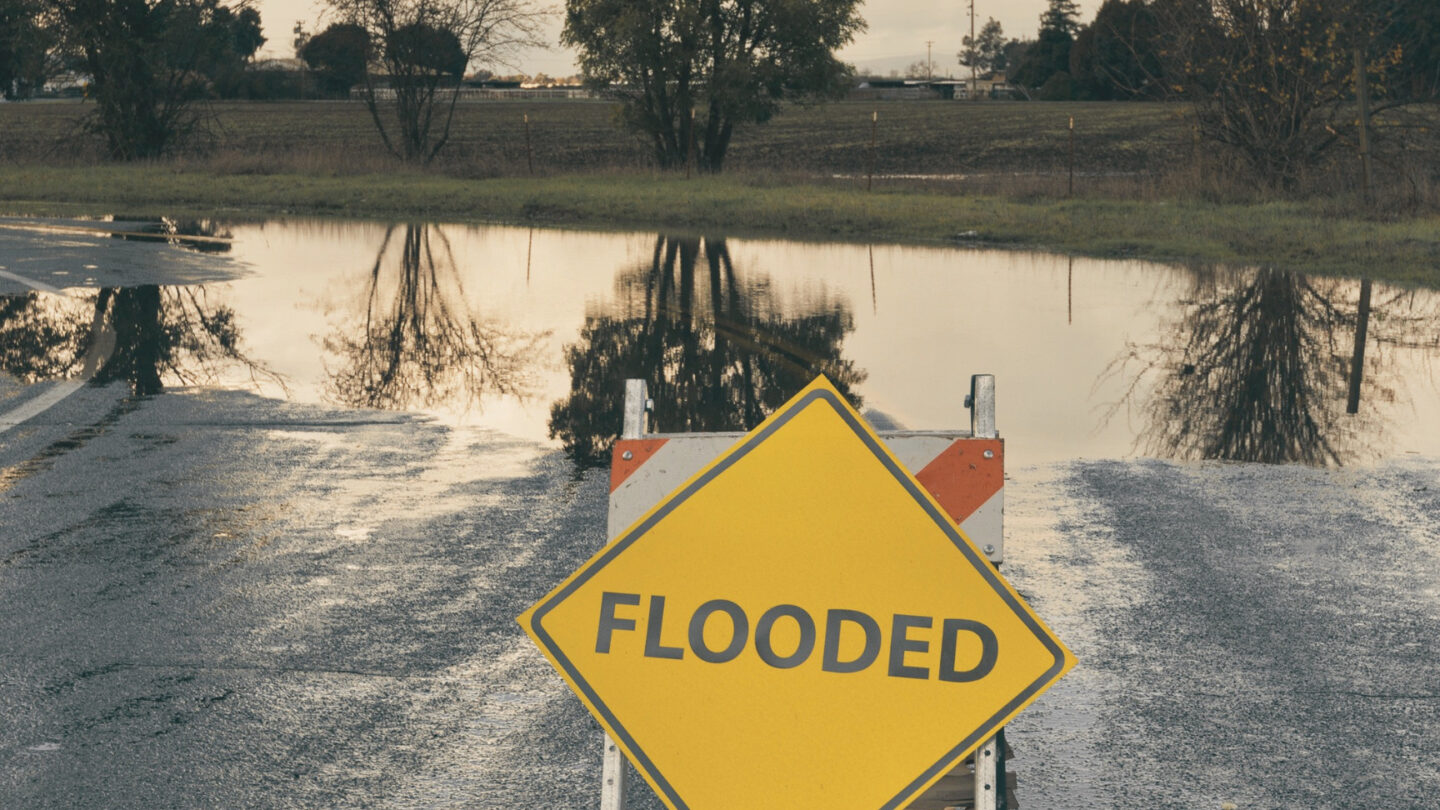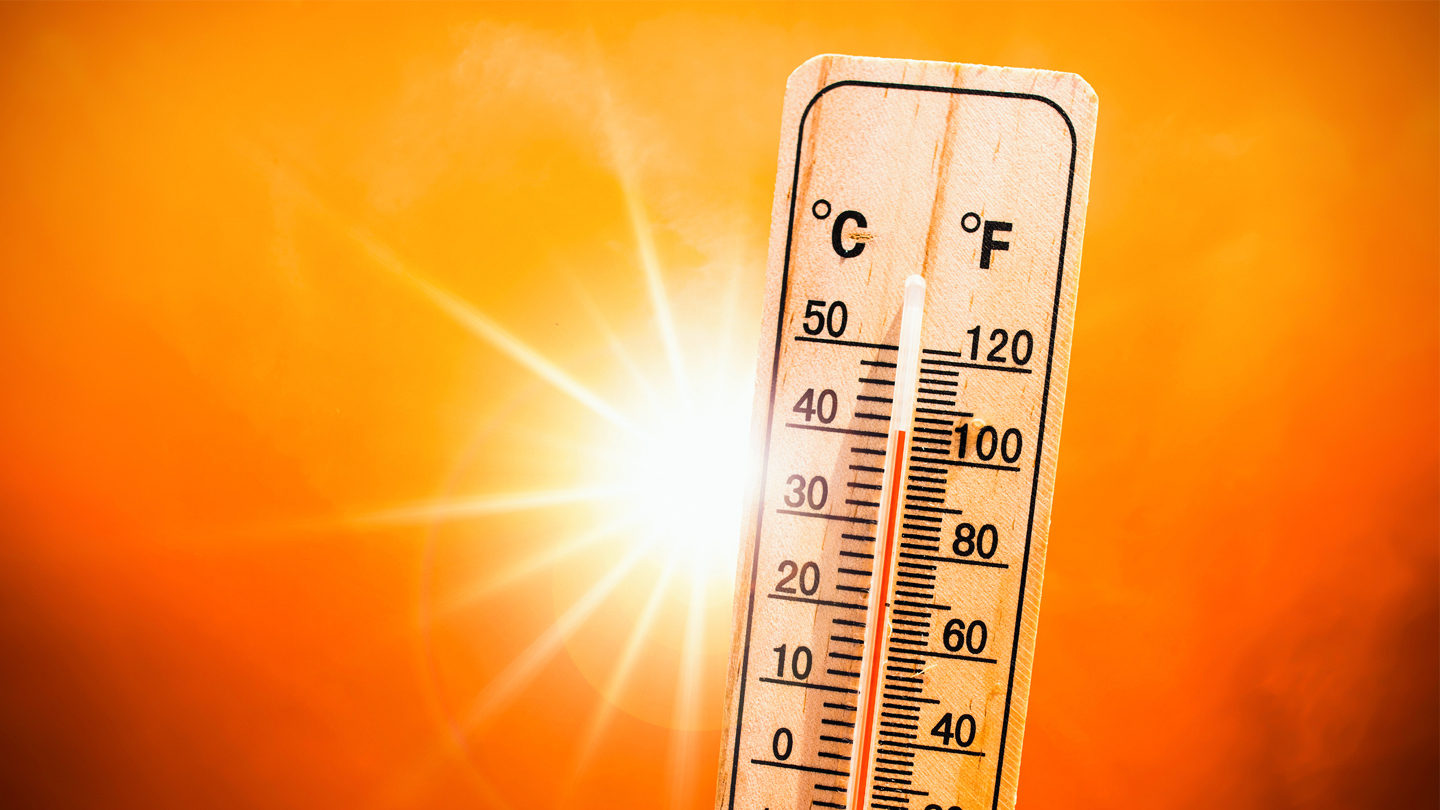
Flooding/Spring Runoff
SPRING RUNOFF
Spring Runoff is the period of time in the spring, typically from April to July, where the creeks swell from snow melt. Flooding may occur where atmospheric conditions lead to rapid melt and stream channels become overwhelmed.
FLOODS/FLASH FLOODING
Flooding is a temporary overflow of water onto land that is normally dry. Floods are the most common natural disaster in the United States. Failing to evacuate flooded areas or entering flood waters can lead to injury or death.

Contact your city officials to see if any local sandbag locations are available.
Salt Lake County Public Works Operations Division
Sandbag Shed (north of main office building)
604 W 6960 S
Maximum allowed: 25
Hours:
8:00 a.m. – 6:00 p.m.
385-468-6101
- Fill sandbags a little over ½ full. If you tie the bag, make sure to leave empty space so the sand has room to move and spread out when the bag is laid flat.
- Bring your own shovel and work gloves.
- Filing is easier with two people.
- Sandbags are your property.
- You are responsible for proper disposal. Used or old sandbags should be disposed of in dumpsters or in bins provided specifically for cleanup (if provided by your local officials). Do not dump sandbags in rivers, creeks, streams, canals, ditches, roadway gutters, or storm drain inlets.
Sandbag bags cost approximately $0.15 to $0.30 (15 to 30 cents) per bag.
Residents are allotted 25 complimentary sandbags per day.
Burlap and Polypropylene sandbags can last up to 8 months to a year; direct sunlight can deteriorate sandbags quickly (shortens lifespan by months).
Sandbags are your property. You are responsible for proper disposal. Do not dump sandbags in rivers, creeks, streams, canals, ditches, roadway gutters, or storm drain inlets. Do not dump sandbags in curbside residential bins (unless directed otherwise by your city or hauler).
Used or old sandbags can be disposed of at dedicated locations provided specifically for sandbag disposal (to be provided by local officials) or taken to the landfill. Sandbag drop-off events are still being coordinated so check back for more information.
Please contact your city first. If you see areas of overland flooding along rivers, creeks, streams, canals, or areas of channel erosion, call Salt Lake County Flood Control.
If you see flooding within local roadways, intersections, or parking lots, this is the responsibility of your municipality. Residents should engage their city resources for local drainage problems before contacting Salt Lake County Flood Control.
Residents are encouraged to visit the SLCO Flood Preparedness website to review the information provided regarding sandbags and other recommendations for use in preparing for flooding events: https://slco.org/flood-control/flood-preparedness-manual/.
No. Once you get sandbags, they are your property and responsibility to dispose of properly.
No, our staffing resources are spread thin, and we do not have the staffing available to send out to assess or assist on a case-by-case basis. Residents are encouraged to work with their neighbors/neighborhood, family members, church groups, and youth groups like Boy/Girl Scouts if they can assist.
If the debris is in a river, creek, stream, or canal, contact SLCO Flood Control at 385-468-6600 or report the issue with the county. If debris is within local roadways or intersections, contact your local city public works for those local drainage problems.
Possible flooding is more likely if your home, residence, or business is located within a FEMAregulated 100-yr floodplain (1-percent Annual Chance Flood) special flood hazard area (SFHA). See link to see if your property falls within a SFHA. We don’t know if spring flooding will occur and if it does, how bad it will be, it’s all about how slowly or quickly the snowpack melts. But, the snowpack will eventually melt and all the creeks, streams, and rivers will rise.
Please visit FEMA’s Flood Map Service Center to see if your property falls within a regulated 100-yr floodplain (1-percent Annual Chance Flood) special flood hazard area (SFHA).
Flood damage from external sources of water (water entering from outside the home), is not typically covered by standard homeowner insurance policies. Flooding can occur from storms, over-saturated ground, rising ground water, overflowing or surging of natural water bodies such as rivers, creeks, streams, ponds, lakes or even runoff from your own back yard. You can purchase a separate flood insurance policy through the National Flood Insurance Program.
If residents see small debris (small branches, sticks, and leaves) blocking or clogging roadside storm drain inlets, residents can help by using a rake and removing and disposing of the debris. This is a quick and easy way to reduce the chances of small nuisance flooding. County and City resources are spread thin and do not have the staff to respond immediately for every storm drain inlet that is blocked and needs to be cleared.
Register to volunteer on our website under Flooding/Spring Runoff. Volunteers will be organized through the local municipalities.
Additional Volunteer Opportunities:
- Salt Lake County Emergency Management
Give Pulse - Utah VOAD (Volunteer Organization)
https://utahvoad.org/ - Just Serve (Volunteer Organization)
https://www.justserve.org/ - Team Rubicon
https://teamrubiconusa.org/volunteer/
SPRING RUNOFF
Heavy rain may bring increased flood risk if gutters and inlets are full of snow and debris. Where’s what you should do to prepare:
- Inspect your rain gutters and downspouts and confirm that they are clear of snow and debris.
- Be sure storm drains closest to your home and the area around them are clear of any debris.
- Pay attention to your landscaping, making sure water drains away from your home.
- Keep children and pets away from potential flood and drainage areas.
- Rain on low-elevation valley snow can melt it quickly and increase runoff along streets and roadways.
- Shallow flooding of parking lots, roadways, and intersections could be possible.
- Watch out for surface runoff and shallow sheet flooding from snow-covered open areas of land or driveways that slope toward a home or residence.
Learn More about Spring Runoff
Salt Lake County Flood and Floodplain Map
FLOODS MAY:
- Result from rain, snow, coastal storms, burn scars from wildfires, storm surges and overflows of dams and other water systems.
- Develop slowly or quickly. Flash floods can come with no warning.
- Cause outages, disrupt transportation, damage buildings, and create landslides.
IF YOU ARE UNDER A FLOOD WARNING:
- Find safe shelter right away.
- Do not walk, swim or drive through flood waters. Turn Around, Don’t Drown!
- Remember, just six inches of moving water can knock you down, and one foot of moving water can sweep your vehicle away.
- Stay off bridges over fast-moving water.
- Depending on the type of flooding:
- Evacuate if told to do so.
- Move to higher ground or a higher floor.
- Stay where you are.

PREPARING FOR A FLOOD
Know Your Risk for Floods
Visit FEMA’s Flood Map Service Center to know types of flood risk in your area. The Emergency Alert System (EAS) and National Oceanic and Atmospheric Administration (NOAA) Weather Radio also provide emergency alerts.
Purchase Flood Insurance
Purchase or renew a flood insurance policy. Homeowner’s insurance policies do not cover flooding. It typically takes up to 30 days for a policy to go into effect so the time to buy is well before a disaster. Get flood coverage under the National Flood Insurance Program (NFIP).
Preparing for a Flood
Make a plan for your household, including your pets so that you and your family know what to do, where to go, and what you will need to protect yourselves from flooding. Learn and practice evacuation routes, shelter plans, and flash flood response. Gather supplies, including non-perishable foods, cleaning supplies, and water for several days, in case you must leave immediately or if services are cut off in your area.
In Case of Emergency
Keep important documents in a waterproof container. Create password-protected digital copies. Protect your property. Move valuables to higher levels. Declutter drains and gutters. Install check valves. Consider a sump pump with a battery.
STAYING SAFE DURING A FLOOD
- Evacuate immediately, if told to evacuate. Never drive around barricades. Local responders use them to safely direct traffic out of flooded areas.
- Contact your healthcare provider If you are sick and need medical attention. Wait for further care instructions and shelter in place, if possible. If you are experiencing a medical emergency, call 9-1-1.
- Listen to EAS, NOAA Weather Radio or local alerting systems for current emergency information and instructions regarding flooding.
- Do not walk, swim, or drive through flood waters. Turn Around. Don’t Drown!
- Stay off bridges over fast-moving water. Fast-moving water can wash bridges away without warning.
- Stay inside your car if it is trapped in rapidly moving water. Get on the roof if water is rising inside the car.
- Get to the highest level if trapped in a building. Only get on the roof if necessary and once there signal for help. Do not climb into a closed attic to avoid getting trapped by rising floodwater.
STAYING SAFE AFTER A FLOOD
- Pay attention to authorities for information and instructions. Return home only when authorities say it is safe.
- Avoid driving except in emergencies.
- Wear heavy work gloves, protective clothing, and boots during clean up and use appropriate face coverings or masks if cleaning mold or other debris.
- People with asthma and other lung conditions and/or immune suppression should not enter buildings with indoor water leaks or mold growth that can be seen or smelled. Children should not take part in disaster cleanup work.
- Be aware that snakes and other animals may be in your house.
- Be aware of the risk of electrocution. Do not touch electrical equipment if it is wet or if you are standing in water. Turn off the electricity to prevent electric shock if it is safe to do so.
- Avoid wading in floodwater, which can be contaminated and contain dangerous debris. Underground or downed power lines can also electrically charge the water.
- Use a generator or other gasoline-powered machinery ONLY outdoors and away from windows.
August 3-4 Severe Thunderstorms & Flooding
U.S. SMALL BUSINESS ADMINISTRATION DISASTER LOANS
Incident: SEVERE THUNDERSTORMS & FLOODING
occurring: August 3 through August 4, 2023
Click here for the SBA Fact Sheet in English
Click Here for the SBA Fact Sheet in Spanish
| Release Date: Oct. 2, 2023 | Media Contact: Mark W. Randle, (916) 735‑1500, [email protected] |
| Release Number: UT 20006-01 | Follow us on Twitter/X, Facebook, Blogs & Instagram |
SBA Offers Disaster Assistance to Utah Businesses and Residents Affected by Severe Thunderstorms and Flooding
SACRAMENTO, Calif. – Low-interest federal disaster loans are available to Utah businesses and residents affected by severe thunderstorms and flooding that occurred Aug. 3 – 4, announced Administrator Isabella Casillas Guzman of the U.S. Small Business Administration. SBA acted under its own authority to declare a disaster in response to a request SBA received from Gov. Spencer Cox, on Sept. 28.
The disaster declaration makes SBA assistance available in Davis, Morgan, Salt Lake, Summit, Tooele, Utah and Wasatch counties.
“SBA’s mission-driven team stands ready to help Utah’s small businesses and residents impacted by severe thunderstorms and flooding,” said Administrator Guzman. “We’re committed to providing federal disaster loans swiftly and efficiently, with a customer-centric approach to help businesses and communities recover and rebuild.”
“Low-interest federal disaster loans are available to businesses of all sizes, most private nonprofit organizations, homeowners and renters whose property was damaged or destroyed by this disaster,” said Director Jeffrey Lusk of the U.S. Small Business Administration’s Disaster Field Operations Center-West. “Beginning Tuesday, Oct. 3, SBA customer service representatives will be on hand at the following Disaster Loan Outreach Center to answer questions about SBA’s disaster loan program, explain the application process and help each individual complete their application,” Lusk continued. The center will be open on the days and times indicated below until further notice. No appointment is necessary.
SALT LAKE COUNTY
Disaster Loan Outreach Center
The Fitzgerald House
1160 E. Pioneer Rd.
Draper, UT 84020
Opens at 9 a.m. Tuesday, Oct. 3
Mondays – Fridays, 9 a.m. – 6 p.m.
Closed Monday, Oct. 9 in observance of Columbus Day
Businesses of all sizes and private nonprofit organizations may borrow up to $2 million to repair or replace damaged or destroyed real estate, machinery and equipment, inventory and other business assets. SBA can also lend additional funds to help with the cost of improvements to protect, prevent or minimize disaster damage from occurring in the future.
For small businesses, small agricultural cooperatives, small businesses engaged in aquaculture and most private nonprofit organizations of any size, SBA offers Economic Injury Disaster Loans to help meet working capital needs caused by the disaster. Economic injury assistance is available regardless of whether the business suffered any property damage.
Disaster loans up to $500,000 are available to homeowners to repair or replace damaged or destroyed real estate. Homeowners and renters are eligible for up to $100,000 to repair or replace damaged or destroyed personal property, including personal vehicles.
Interest rates can be as low as 4 percent for businesses, 2.375 percent for private nonprofit organizations and 2.5 percent for homeowners and renters with terms up to 30 years. Loan amounts and terms are set by SBA and are based on each applicant’s financial condition.
Interest does not begin to accrue until 12 months from the date of the first disaster loan disbursement. SBA disaster loan repayment begins 12 months from the date of the first disbursement.
Applicants may apply online, receive additional disaster assistance information and download applications at https://disasterloanassistance.sba.gov/. Applicants may also call SBA’s Customer Service Center at (800) 659-2955 or email [email protected] for more information on SBA disaster assistance. For people who are deaf, hard of hearing, or have a speech disability, please dial 7-1-1 to access telecommunications relay services. Completed applications should be mailed to U.S. Small Business Administration, Processing and Disbursement Center, 14925 Kingsport Road, Fort Worth, TX 76155.
The deadline to apply for property damage is Dec. 1, 2023.
The deadline to apply for economic injury is July 2, 2024.
About the U.S. Small Business Administration
The U.S. Small Business Administration helps power the American dream of business ownership. As the only go-to resource and voice for small businesses backed by the strength of the federal government, the SBA empowers entrepreneurs and small business owners with the resources and support they need to start, grow, expand their businesses, or recover from a declared disaster. It delivers services through an extensive network of SBA field offices and partnerships with public and private organizations. To learn more, visit www.sba.gov.
COMUNICADO DE PRENSA
Disaster Field Operations Center West
| Fecha: 2 de octubre de 2023 | Contacto para la Prensa: Mark W. Randle, (916) 735 1500, [email protected] |
| Número: UT 20006-01 | Síguenos en Twitter/X, Facebook, Blogs & Instagram |
La SBA Ofrece Asistencia de Desastres a los Negocios y Residentes del Estado de Utah afectados por las Severas Tormentas Eléctricas e Inundaciones
SACRAMENTO, Calif. – Préstamos federales para desastres a bajos intereses están disponibles para los negocios y residentes del estado de Utah que se vieron afectados por las severas tormentas eléctricas e inundaciones que ocurrieron del 3 al 4 de agosto, anunció la Administradora Isabella Casillas Guzman de la Agencia Federal de Pequeños Negocios (SBA, por sus siglas en inglés). La SBA decidió bajo su propia autoridad declarar un desastre en respuesta a la solicitud del Gobernador Spencer Cox recibida por la SBA el 28 de septiembre.
La declaración de desastre pone la asistencia de la SBA disponible en los condados de Davis, Morgan, Salt Lake, Summit, Tooele, Utah y Wasatch.
“El equipo impulsado por la misión de la SBA está listo para ayudar a los negocios pequeños y residentes de Utah impactados por las severas tormentas eléctricas e inundaciones,” dijo la Administradora Guzman. “Estamos comprometidos a proporcionar préstamos para desastres federales lo más rápido y eficientemente, con un enfoque centrado en el cliente para ayudar a los negocios y las comunidades recuperarse y reconstruir.”
“Préstamos federales para desastres a bajos intereses están disponibles para negocios de cualquier tamaño, la mayoría de las organizaciones privadas sin fines de lucro, propietarios de vivienda e inquilinos que sufrieron daños o destrucción en su propiedad por el desastre,” dijo Jeffrey Lusk, Director del Centro de Desastres del Oeste (Disaster Field Operations Center-West) de la Agencia Federal de Pequeños Negocios (SBA, por sus siglas en inglés). “A partir del martes, 3 de octubre, representantes de la SBA estarán disponibles en el siguiente Centro de Promoción y Asistencia para Préstamos de Desastre (DLOC, por sus siglas en inglés) para responder a sus preguntas sobre el programa de préstamos para desastres, explicarles el proceso de la solicitud y ayudar a cada persona a completar su solicitud,” agregó Lusk. El centro estará abierto los días y horarios indicados a continuación. No es necesario hacer una cita.
CONDADO DE SALT LAKE Centro de Promoción y Asistencia para Préstamos de Desastres The Fitzgerald House 1160 East Pioneer Road Draper, UT 84020 Abrirá el martes, 3 de octubre, a las 9 a.m. Lunes – viernes, 9 a.m. – 6 p.m. Cerrado el lunes, 9 de octubre, para el Día de la Raza |
Negocios de cualquier tamaño y organizaciones privadas sin fines de lucro pueden obtener préstamos hasta $2 millones de dólares para reparar o reemplazar bienes inmuebles, maquinarias y equipos, inventarios y otros activos.La SBA también puede prestar fondos adicionales para ayudar con el costo de las mejoras destinadas a proteger, prevenir o minimizar daños por desastres que ocurran en el futuro.
Para los pequeños negocios, las pequeñas cooperativas agrícolas, los pequeños negocios involucrados en acuacultura, y para la mayoría de las organizaciones privadas sin fines de lucro de todos los tamaños, la SBA ofrece Préstamos de Desastre por Daños Económicos (EIDL, por sus siglas en inglés) para ayudar a cubrir las necesidades de capital circulante causadas por el desastre. La asistencia por daños económicos está disponible independientemente de si el negocio ha sufrido algún daño físico en la propiedad.
Los préstamos para desastres disponibles para propietarios de viviendas pueden ser hasta de $500,000 para reparar o reemplazar su residencia principal. Propietarios de viviendas e inquilinos pueden solicitar hasta $100,000 para reparar o reemplazar su propiedad personal dañada o destruida, incluyendo vehículos personales.
Las tasas de interés de los préstamos pueden ser tan bajas como 4 por ciento para negocios, 2.375 por ciento para organizaciones privadas sin fines de lucro y 2.5 por ciento para propietarios de vivienda e inquilinos por plazos de hasta 30 años. Los montos y términos de los préstamos los establece la SBA y se basan en las condiciones financieras de cada solicitante.
Los intereses no comienzan a acumularse hasta 12 meses después de la fecha del desembolso inicial del préstamo para desastres. El pago del préstamo por desastre de la SBA comienza 12 meses después de la fecha del primer desembolso.
Los interesados pueden llenar una solicitud en línea, recibir información adicional sobre asistencia de desastres y descargar la solicitud de préstamo en https://disasterloanassistance.sba.gov/. También pueden comunicarse al Centro de Servicio a Clientes para Asistencia de Desastres de la SBA marcando (800) 659‑2955 o enviando un correo electrónico a [email protected] para obtener mayor información. Para las personas con discapacidades auditivas o del habla, favor de marcar 7-1-1 para tener acceso al servicio de retransmisión de telecomunicaciones. Las solicitudes completadas en papel deben enviarse por correo a U.S. Small Business Administration, Processing and Disbursement Center, 14925 Kingsport Road, Fort Worth, TX 76155.
La fecha límite para solicitar un préstamo por daños físicos es el 1 de diciembre de 2023. La fecha límite para solicitar un préstamo por daños económicos es el 2 de julio de 2024.
Acerca de la Agencia Federal de Pequeños Negocios
La Agencia Federal de Pequeños Negocios hace realidad el sueño americano de ser propietario de un negocio. Como único recurso y voz para las pequeñas empresas y con el respaldo de la fortaleza del gobierno federal, la SBA permite a los empresarios y propietarios de pequeños negocios contar con los recursos y el apoyo que necesitan para crear, desarrollar o ampliar sus negocios o recuperarse de un desastre declarado. Ofrece servicios a través de su amplia red de oficinas de campo y asociaciones con organizaciones públicas y privadas. Para obtener más información, visite www.sba.gov o www.sba.gov/espanol.
Extreme Heat
Extreme heat is a period of high heat and humidity with temperatures above 90 degrees for at least two to three days. In extreme heat your body works extra hard to maintain a normal temperature, which can lead to death. Extreme heat is responsible for the highest number of annual deaths among all weather-related hazards. Older adults, children and sick or overweight individuals are at greater risk from extreme heat. Humidity increases the feeling of heat.
PREPARE FOR EXTREME HEAT
- Learn to recognize the signs of heat illness.
- Do not rely on a fan as your primary cooling device. Fans create air flow and a false sense of comfort, but do not reduce body temperature or prevent heat-related illnesses.
- Identify places in your community where you can go to get cool such as libraries and shopping malls or visit one of Salt Lake County’s many cooling centers.
- Cover windows with drapes or shades.
- Weather-strip doors and windows.
- Use window reflectors specifically designed to reflect heat back outside.
- Add insulation to keep the heat out.
- Use a powered attic ventilator, or attic fan, to regulate the heat level of a building’s attic by clearing out hot air.
- Install window air conditioners and insulate around them.
- If you are unable to afford your cooling costs, weatherization, or energy-related home repairs, contact the Low Income Home Energy Assistance Program (LIHEAP) for help.
STAY SAFE DURING EXTREME HEAT
- Never leave people or pets in a closed car on a warm day.
- If air conditioning is not available in your home, go to a cooling center.
- Take cool showers or baths.
- Wear loose, lightweight, light-colored clothing.
- Use your oven less to help reduce the temperature in your home.
- If you’re outside, find shade. Wear a hat wide enough to protect your face.
- Drink plenty of fluids to stay hydrated.
- Avoid high-energy activities or work outdoors, during midday heat, if possible.
- Check on family members, seniors, and neighbors.
- Watch for heat cramps, heat exhaustion and heat stroke.
- Consider pet safety. If they are outside, make sure they have plenty of cool water and access to comfortable shade. Asphalt and dark pavement can be very hot to your pet’s feet.
- If using a mask, use one that is made of breathable fabric, such as cotton, instead of polyester. Don’t wear a mask if you feel yourself overheating or have trouble breathing.
HEAT-RELATED ILLNESSES
Know the signs of heat-related illnesses and ways to respond. If you are sick and need medical attention, contact your healthcare provider for advice and shelter in place if you can. If you are experiencing a medical emergency call 9-1-1.
Get more detailed information about heat-related illnesses from the CDC and National Weather Service.
HEAT STROKE
Signs:
- Extremely high body temperature (above 103 degrees F) taken orally
- Red, hot, and dry skin with no sweat
- Rapid, strong pulse
- Dizziness, confusion, or unconsciousness
If you suspect heat stroke, call 9-1-1 or get the person to a hospital immediately. Cool down with whatever methods are available until medical help arrives. Do not give the person anything to drink.
HEAT CRAMPS
Signs:
- Muscle pains or spasms in the stomach, arms, or legs
HEAT EXHAUSTION
Signs:
- Heavy sweating, paleness
- Muscle cramps
- Tiredness, weakness
- Fast or weak pulse
- Dizziness
- Headache, fainting
- Nausea, vomiting
If you have signs of heat cramps or heat exhaustion, go to a cooler location, and cool down by removing excess clothing and taking sips of sports drinks or water. Call your healthcare provider if symptoms get worse or last more than an hour.
Associated Content
- Extreme Heat Information Sheet (PDF)
- Children, Pets and Vehicles (weather.gov)
- You Can Help Prevent Hot Car Deaths (NHTSA)
- Protective Actions Research for Extreme Heat
- National Weather Service Heat Safety Tips and Resources
- National Weather Service – Heat Illnesses
- Centers for Disease Control and Prevention: Extreme Heat
- Warning Signs and Symptoms of Heat-Related Illness
- National Integrated Heat Health Information System

